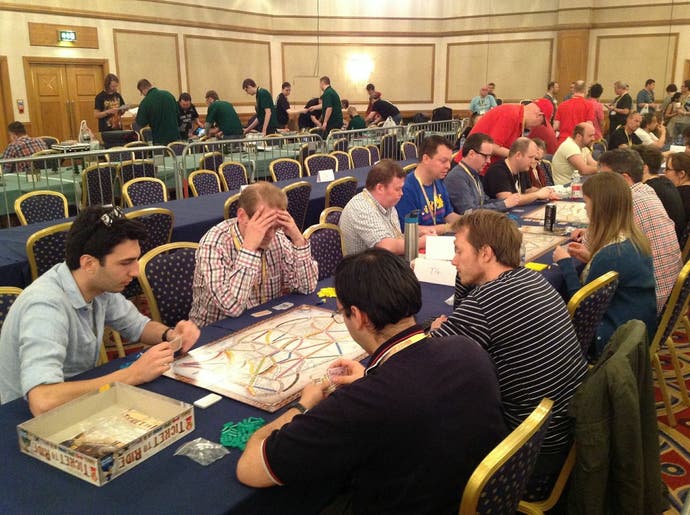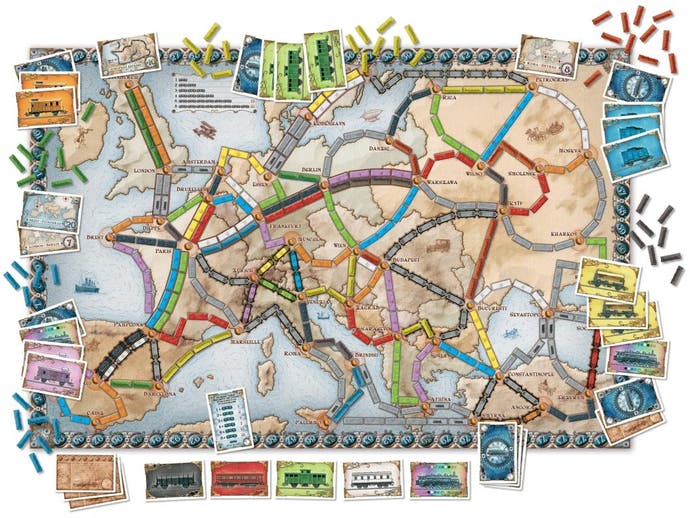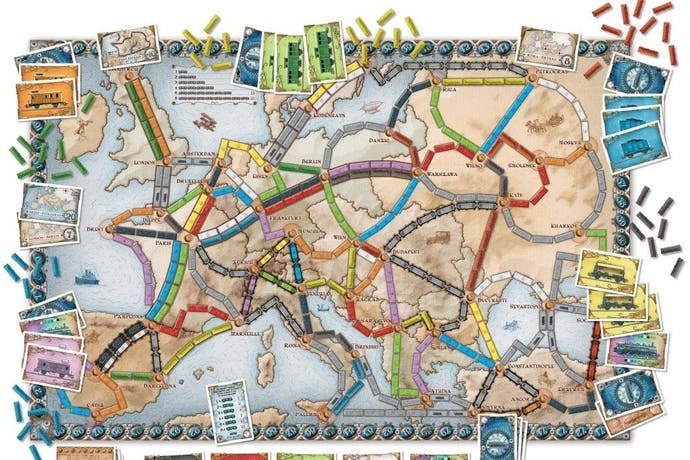Alan R Moon, railroad tycoon
Ticket to Ride's designer tracks his success?.
Most will tell you there are three gateways to the world of 'proper' tabletop gaming.?
?Settlers of Catan is undoubtedly the titan, serving board games in the same way Watchmen stands as a cultural ambassador for the graphic novel. Then there is Carcassonne, a gentler territory control title that dissolves away the symbols and numbers of strategy tabletop to leave a map building game that, on occasion, plays like a collective creative pursuit.
??But perhaps the most elegant, welcoming and compelling of the holy triptych of board gaming gateway drugs is Ticket to Ride. Presented as a tale of eccentric adventurers racing trains across America, the base game offers a near-faultless balance of depth, simplicity, and the all-important ease of teaching that ensures tabletop spreads like a cardboard virus through the world's living rooms.?
?And now Ticket to Ride has reached the grand old age of ten years in service. There's a special edition out, and its designer Alan R Moon has returned to the limelight to promote his creation.?
?The Ticket to Ride base game - which has sold millions of copies, spawned numerous expansions and been showered with awards, including the prestigious Spiel Des Jahres - has enjoyed years at the tip of the spear of the movement to popularise tabletop beyond traditional family gaming, even making its way into high street chain stores across the UK. As such, its contribution to the hobby is vast. But the original concept? A complete and playable vision popped into Moon's head in an instant, 90 per cent of which he says made it to the final production version.?

?"It really was a single moment," he muses. "The night before I had helped prototype play a more complicated gamers' railroad game, and it had not worked well at all."
?Later that day the Southampton born, US-based designer found himself strolling along the shore in Beverly, Massachusetts pondering that doomed game and its failings. He wracked his brains for a solution.?
?"All of a sudden there was a lightbulb moment, and another game leapt into my mind," Moon reveals. "As I walked, I was designing and playing Ticket to Ride in my head, and I couldn't wait to get home to prototype. And that prototype was about 90 per cent of the published game. That's so unusual; it normally takes so much more work changing the original idea."
??Moon certainly isn't an arrogant creative, and admits his ideas don't normally come quite so easily. In fact, while he has prototyped dozens of ideas since Ticket to Ride's 2004 debut, he claims to have taken just two to publishers in the past ten years, leaving a library of abandoned concepts on his shelves.?
?"Having the ideas, and playing the prototype in your head is so much fun," enthuses Moon, as a smile edges across his face. "At that time I'm always sure it's the best game there's ever been, and I can't wait to play it with other people. Then you make the prototype and play it with other people, and most of the time it isn't as great as you'd imagined.?
?"In fact, I'll be honest. Almost all the time the early prototype is not quite as good as I imagine.? ?"When I started, maybe 20 years ago, the prototypes I showed to people; well, maybe 90 per cent of them weren't good games," confesses Moon. "Now that percentage is maybe 50-50. And then of the good 50, many would only ever sell very limited numbers, because they are true gamer's games with niche appeal. What I'm really looking for is making another game that will appeal to a much wider audience."

??So why all the games that - by Moon's standards at least - are less than dazzling?
?For the designer, it's about perfection. Moon is on a quest to create another game with the impact of Ticket to Ride; a release with all the simplicity, elegance and grace that has made his railroad adventure an icon of tabletop.?
?Fortunately, he has a fairly solid idea of what makes a game. Or, to put it more accurately, Moon is certain what shouldn't be in a good game.?
?"My rule for designing a game is that anything I can take out of the game, I take out, as long as it doesn't undermine the base part," states Moon. "When I worked at Avalon Hill on gamers' wargames, I learned a lot about making complex rules and coating a game with a lot of 'chrome', to dress up the game. For me as a designer I really want to do the opposite with my designs. I want to take everything out that's possible, and have a really elegant design."?
?The rest of Moon's rules for design are fairly simple. The player, he insists, should be limited to two or three simple choices per turn, and learn fairly quickly if decisions made were the right ones. Moon has no time for what he calls 'game salad', where the player can juggle myriad ways to claim victory. Instead, the same limited decisions should also continue to impact the rest of the game. And maths? Moon doesn't want his gamers to notice any numeric systems. They, he says, are far to dull for his creations. Play should be quick too, and systems taken back to their most refined form.?
?"Within those rules Ticket to Ride is stripped back as far as I think is possible," says Moon. "I don't think there's anything left in there that you could take out without effecting the game's most base level."?
?But tabletop is rarely at its best when a game is explicitly just a system. How a game feels to play is important. It is something Moon is acutely aware of, and his method for infusing his creations with feeling is a personal one.?
?Moon fell in love with tabletop games as a child. His family would meet every Sunday, take in a museum or go bowling, and then rush home to play games together. Moon had time for video games, from Frenzy to the 1981 Castle Wolfenstein. He even bought an Apple IIe to play Wizardry, which he tackled blissfully unaware that save files were possible, restarting the game from scratch when his party perished. Finally introduced to the idea of backing up progress, he even felt disappointed he could rely on the computer's help. ?
?But it was tabletop gaming with his family he loved most.? ? "It made me very happy," he remembers. "Even when I was a teenager and - you know - you don't want to be with your parents all the time, I adored playing games with them. Maybe like any teenager I didn't appreciate going out with them quite so much, but I always looked forward to playing games with them."?
?Eventually, at college, the gamer became a designer. Moon started to contribute articles to The General, the official magazine of Avalon Hill's games. In due course the aspiring journalist was hired as editor, but on taking the reigns in his hands he found he gravitated most naturally to helping prototype and develop the games at Avalon Hill. And so the game designer flame was ignited.??

And then there was a love of railroads.?
?"People will tell you my games are all about transportation and moving from place to place." Offers Moon. "Well, that's my joy in life. I love trains, I love geography, I love travelling. I love model railroads too."?
?Moon's journey to board game designer had come about through a love of family time, all seasoned with a passion for travel. How those two parts of his life manifest themselves in a railroad game popular with diverse social groups of every ability level seems obvious. Moon's life has influenced the themes of the games he has made, and the gatherings he has conceived them for. But
Moon's games are also a chance for the designer to explore what he is not as a human.?
?"I do try and force myself out of a certain path with my life through board game design," he confirms. "I'm rather symmetrical in my approach to life - very orderly. And perhaps I'd like to be a little more random as a person; a little less ordered. So I try and explore that with my games.??
"When I'm designing a game I'll get to a point where a part feels too much like me; too symmetrical, so I'll throw some randomness into the pot there, and create something more random. I absolutely get to explore how I could be different through designing games."??
And so it is that Ticket to Ride is an amalgamation of all that is Alan R Moon. His history, his passions, and what he would like to be are all manifested in a strikingly simple train game. And that may be what it takes to design an influential piece of tabletop that welcomes thousands of new fans to the pastime. Even if it does also mean designing a wall of unpublished prototypes.?
?Fortunately for fans of Ticket to Ride, Moon isn't done yet, revealing that his next great idea might almost be ready.? ?"With each of those prototypes, I didn't think they were exactly what I wanted my next game to be. But I'll keep on trying. I'm always looking for that next game, and I really think I have it now. I'm close. But you never know. Ultimately that happens when a game gets published."? ? Fortunately for Moon and his fans, the creator of Ticket to Ride shouldn't have too much trouble attracting the attention of those that take games from finished prototype to player tables the world over.?
This article is based on a press trip to Paris, and game distributor Esdevium paid for travel costs.

